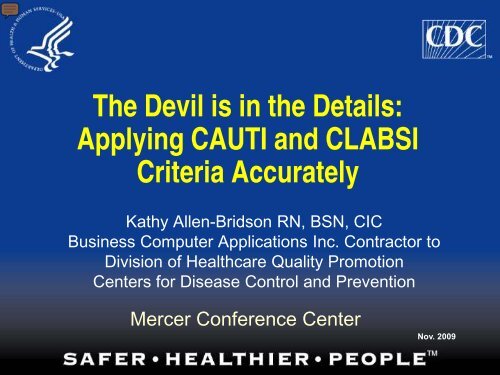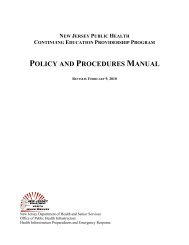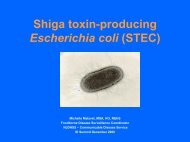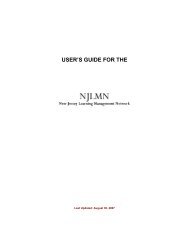The Devil is in the Details: Applying CAUTI and CLABSI Criteria ...
The Devil is in the Details: Applying CAUTI and CLABSI Criteria ...
The Devil is in the Details: Applying CAUTI and CLABSI Criteria ...
You also want an ePaper? Increase the reach of your titles
YUMPU automatically turns print PDFs into web optimized ePapers that Google loves.
<strong>The</strong> <strong>Devil</strong> <strong>is</strong> <strong>in</strong> <strong>the</strong> <strong>Details</strong>:<br />
Apply<strong>in</strong>g <strong>CAUTI</strong> <strong>and</strong> <strong>CLABSI</strong><br />
<strong>Criteria</strong> Accurately<br />
Kathy Allen-Bridson RN, BSN, CIC<br />
Bus<strong>in</strong>ess Computer Applications Inc. Contractor to<br />
Div<strong>is</strong>ion of Healthcare Quality Promotion<br />
Centers for D<strong>is</strong>ease Control <strong>and</strong> Prevention<br />
Mercer Conference Center<br />
Nov. 2009
Objectives<br />
1. State <strong>the</strong> Centers for D<strong>is</strong>ease Control<br />
<strong>and</strong> Prevention’s def<strong>in</strong>itions <strong>and</strong> criteria<br />
of Ca<strong>the</strong>ter-associated Ur<strong>in</strong>ary Tract<br />
Infection (<strong>CAUTI</strong>) <strong>and</strong> Central L<strong>in</strong>eassociated<br />
Bloodstream Infection<br />
(<strong>CLABSI</strong>)<br />
2. Correctly identify <strong>CAUTI</strong> <strong>and</strong> <strong>CLABSI</strong> as<br />
applied to case studies<br />
3. State <strong>the</strong> correct method to identify<br />
denom<strong>in</strong>ators for <strong>CAUTI</strong> <strong>and</strong> <strong>CLABSI</strong><br />
rate calculations.
NHSN Website<br />
A Valuable Resource<br />
• NHSN Manual<br />
– <strong>Criteria</strong><br />
– Key Def<strong>in</strong>itions<br />
– Tables of Instructions<br />
• Data <strong>and</strong> Stat<strong>is</strong>tics<br />
– NHSN publ<strong>is</strong>hed reports<br />
• Tra<strong>in</strong><strong>in</strong>gs<br />
• NHSN forms<br />
• Lots more!!!<br />
http://www.cdc.gov/nhsn/<strong>in</strong>dex.html
http://www.cdc.gov/nhsn/PDFs/ICD-9-cmCODEScurrent.pdf
Horan TC, Andrus ML, Dudeck MA. CDC/NHSN surveillance def<strong>in</strong>ition of healthcareassociated<br />
<strong>in</strong>fection <strong>and</strong> criteria for specific types of <strong>in</strong>fections <strong>in</strong> <strong>the</strong> acute care<br />
sett<strong>in</strong>g. Am J Infect Control 2008;36:309-32.<br />
http://www.cdc.gov/ncidod/dhqp/pdf/NNIS/NosInfDef<strong>in</strong>itions.pdf
Cons<strong>is</strong>tency <strong>is</strong> a Must!<br />
• <strong>Criteria</strong> designed to look at a<br />
population at r<strong>is</strong>k<br />
• Identify patients meet<strong>in</strong>g <strong>the</strong><br />
criteria<br />
• Cons<strong>is</strong>tently apply <strong>the</strong> criteria<br />
• Ensures <strong>the</strong> comparability of <strong>the</strong><br />
data- protects your facility <strong>and</strong><br />
o<strong>the</strong>rs
What If My Physician’s<br />
Balk?<br />
• Rem<strong>in</strong>d of surveillance vs. cl<strong>in</strong>ical<br />
def<strong>in</strong>itions<br />
– Diff purposes<br />
– May not be <strong>the</strong> same<br />
– Comments section useful to note<br />
important factors<br />
• Can submit questions to NHSN<br />
mailbox
Healthcare-associated Infection<br />
(HAI)<br />
• A localized or systemic condition result<strong>in</strong>g from an<br />
adverse reaction to <strong>the</strong> presence of an <strong>in</strong>fectious<br />
agent(s) or its tox<strong>in</strong>(s) that<br />
– Occurs <strong>in</strong> a patient <strong>in</strong> a healthcare sett<strong>in</strong>g <strong>and</strong><br />
– Was not present or <strong>in</strong>cubat<strong>in</strong>g at <strong>the</strong> time of<br />
adm<strong>is</strong>sion, unless <strong>the</strong> <strong>in</strong>fection was related<br />
to a previous adm<strong>is</strong>sion<br />
• When <strong>the</strong> sett<strong>in</strong>g <strong>is</strong> a hospital, meets <strong>the</strong> criteria<br />
for a specific <strong>in</strong>fection (body) site as def<strong>in</strong>ed by<br />
CDC<br />
• When <strong>the</strong> sett<strong>in</strong>g <strong>is</strong> a hospital, may also be called<br />
a nosocomial <strong>in</strong>fection
Major & Specific<br />
Infection Types
<strong>CAUTI</strong> <strong>and</strong> <strong>CLABSI</strong> <strong>Criteria</strong><br />
<strong>and</strong> Application
Ca<strong>the</strong>ter-associated Ur<strong>in</strong>ary Tract<br />
Infection (<strong>CAUTI</strong>)
Ca<strong>the</strong>ter-associated Ur<strong>in</strong>ary<br />
Tract Infection (<strong>CAUTI</strong>)<br />
Surveillance<br />
• Most common HAI<br />
• Rates range between<br />
– 16.8% <strong>in</strong> Rehab<br />
– 3.1% <strong>in</strong> Med Surg ICU non-major teach<strong>in</strong>g<br />
facility<br />
• Renewed <strong>in</strong>terest:<br />
– M<strong>and</strong>atory report<strong>in</strong>g<br />
– Denial of CMS reimbursement dollars
Major & Specific Infection<br />
Types- UTI<br />
• Major: Ur<strong>in</strong>ary Tract Infection<br />
(UTI)<br />
• Specific:<br />
– Symptomatic UTI (SUTI)<br />
– Asymptomatic Bacteremic UTI<br />
(ABUTI)<br />
– O<strong>the</strong>r UTI (OUTI)<br />
<strong>CAUTI</strong>= UTI where an <strong>in</strong>dwelll<strong>in</strong>g ur<strong>in</strong>ary ca<strong>the</strong>ter<br />
was <strong>in</strong> place <strong>in</strong> <strong>the</strong> 48 hours prior to <strong>in</strong>fection<br />
onset
<strong>CAUTI</strong><br />
A UTI when an <strong>in</strong>dwelll<strong>in</strong>g ur<strong>in</strong>ary ca<strong>the</strong>ter<br />
was <strong>in</strong> place <strong>in</strong> <strong>the</strong> 48 hours prior to<br />
<strong>in</strong>fection onset<br />
*Note: <strong>The</strong>re <strong>is</strong> no m<strong>in</strong>imum period of time<br />
that <strong>the</strong> ca<strong>the</strong>ter must be <strong>in</strong> place I norder<br />
for <strong>the</strong> UTI to be considered ca<strong>the</strong>terassociated.<br />
*Note: SUTI 1b <strong>and</strong> 2b <strong>and</strong> O<strong>the</strong>r UTI cannot<br />
be ca<strong>the</strong>ter-associated.
Indwell<strong>in</strong>g Ca<strong>the</strong>ter<br />
• A dra<strong>in</strong>age tube that <strong>is</strong> <strong>in</strong>serted<br />
<strong>in</strong>to <strong>the</strong> ur<strong>in</strong>ary bladder through <strong>the</strong><br />
urethra, <strong>is</strong> left <strong>in</strong> place, <strong>and</strong> <strong>is</strong><br />
connected to a closed collection<br />
system; also called a Foley<br />
ca<strong>the</strong>ter; does not <strong>in</strong>clude:<br />
– straight <strong>in</strong> <strong>and</strong> out ca<strong>the</strong>ters<br />
– Suprapubic ca<strong>the</strong>ters<br />
– Nephrostomy tubes
<strong>CAUTI</strong> Denom<strong>in</strong>ator Data<br />
• <strong>CAUTI</strong>s are attributed to patient<br />
location<br />
• # <strong>in</strong>dwell<strong>in</strong>g ur<strong>in</strong>ary ca<strong>the</strong>ter days/<br />
unit<br />
• For ur<strong>in</strong>ary ca<strong>the</strong>ter device<br />
utilization: # patient days/unit
48 Hour Rule<br />
• If a <strong>CAUTI</strong> develops with<strong>in</strong> 48<br />
hours of transfer from one <strong>in</strong>patient<br />
location to ano<strong>the</strong>r <strong>in</strong> <strong>the</strong> same<br />
facility, <strong>the</strong> <strong>in</strong>fection <strong>is</strong> attributed to<br />
<strong>the</strong> transferr<strong>in</strong>g location.<br />
Th<strong>is</strong> rule applies to <strong>CLABSI</strong> surveillance also.
Example of Completed Denom<strong>in</strong>ators<br />
for ICU/O<strong>the</strong>r Locations Form<br />
10000 Nov<br />
2008 MSICU<br />
6<br />
8<br />
6<br />
7<br />
6<br />
8<br />
6<br />
6<br />
4<br />
7<br />
6<br />
6<br />
//<br />
//<br />
151 138
2 Key Questions<br />
• Was an <strong>in</strong>dwell<strong>in</strong>g ca<strong>the</strong>ter <strong>in</strong><br />
place at <strong>the</strong> time of or with<strong>in</strong> 48<br />
hours prior to <strong>the</strong> ur<strong>in</strong>e specimen<br />
collection?<br />
• Is <strong>the</strong> patient 65 years or older?
Symptomatic UTI – 1a & 1b<br />
1 a <strong>and</strong> 1 b
Symptomatic UTI – 2a
Symptomatic UTI – 2b
SUTI for ≤1 year olds –<br />
<strong>Criteria</strong> 3 & 4
SUTI 1a & 2a Ca<strong>the</strong>ter <strong>in</strong><br />
Place Flow Diagram
Asymptomatic Bacteremic UTI<br />
(ABUTI)
Determ<strong>in</strong>es if<br />
age <strong>is</strong> a<br />
factor
Available<br />
selections<br />
based on<br />
Specific<br />
Event<br />
Type
Case 1<br />
• Patient with end stage pancreatic cancer with liver &<br />
bone mets admitted to hospital with advance<br />
directive for comfort care <strong>and</strong> antibiotics only;<br />
peripheral IV <strong>and</strong> nasal cannula <strong>in</strong>serted<br />
• Day 4: patient <strong>is</strong> febrile <strong>and</strong> has suprapubic<br />
tenderness; IV ampicill<strong>in</strong> started after ur<strong>in</strong>e obta<strong>in</strong>ed<br />
for culture<br />
• Day 5: difficulty breath<strong>in</strong>g; CXR=<strong>in</strong>filtrate L lung<br />
base<br />
• Day 6: ur<strong>in</strong>e culture results = 10 5 CFU/ml E coli<br />
• Day 7: WBC/mm 3 = 3400; patchy <strong>in</strong>filtrates <strong>in</strong> both<br />
lung bases; cont<strong>in</strong>ued ep<strong>is</strong>odes of dyspnea; rales<br />
noted <strong>in</strong> LLL<br />
• Day 11: Patient expired
Case 1<br />
• Does th<strong>is</strong> patient have an HAI?<br />
• What type(s)?<br />
• Device associated?
Case 2<br />
• POD 3: 66 y.o. patient <strong>in</strong> <strong>the</strong> ICU with a Foley<br />
ca<strong>the</strong>ter s/p exploratory lap; patient noted to<br />
be febrile (38.9 ) <strong>and</strong> compla<strong>in</strong>ed of diffuse<br />
abdom<strong>in</strong>al pa<strong>in</strong><br />
• WBC <strong>in</strong>creased to 19,000. He had cloudy,<br />
foul-smell<strong>in</strong>g ur<strong>in</strong>e <strong>and</strong> ur<strong>in</strong>alys<strong>is</strong> showed 2+<br />
prote<strong>in</strong>, + nitrite, 2+ leukocyte esterase, wbc –<br />
TNTC, <strong>and</strong> 3+ bacteria. Culture was 10,000<br />
CFU/ml E. coli. <strong>The</strong> abdom<strong>in</strong>al pa<strong>in</strong> seemed<br />
localized to surgical area<br />
Is th<strong>is</strong> a UTI?<br />
If so, what type?<br />
<strong>Criteria</strong>?
Case 3<br />
• 84 year old patient <strong>is</strong> hospitalized with GI bleed<br />
• Day 3: Patient has ca<strong>the</strong>ter <strong>in</strong> place <strong>and</strong> no signs or<br />
symptoms of <strong>in</strong>fection<br />
• Day 9: Patient becomes unresponsive, <strong>is</strong> <strong>in</strong>tubated <strong>and</strong><br />
CBC shows WBC of 15,000. Temp 38.5 C. Patient <strong>is</strong><br />
pan-cultured. Blood culture <strong>and</strong> ur<strong>in</strong>e both grow<br />
Streptococcus pyogenes – ur<strong>in</strong>e >10 5 CFU/ml.<br />
Is th<strong>is</strong> a UTI?<br />
If so, what type?
Case 4<br />
• 3 week old <strong>in</strong>fant born at 27 weeks gestation.<br />
Umbilical ca<strong>the</strong>ter <strong>in</strong> place. HR 100, RR 32,<br />
<strong>and</strong> core temperature ranges between 37.8 C<br />
<strong>and</strong> 36.2 C. Straight cath ur<strong>in</strong>e culture yields<br />
>10 5 CFU/ml Staphylococcus epidermid<strong>is</strong>.<br />
• 1 blood culture sent same day, also positive<br />
for S. epi. No susceptibilities provided.<br />
Is th<strong>is</strong> a UTI?<br />
If so, what type?
Case 4<br />
• What if <strong>the</strong> one blood <strong>and</strong> ur<strong>in</strong>e culture had<br />
been positive for a Micrococcus not<br />
speciated?<br />
Is th<strong>is</strong> now a UTI?<br />
If so, what type?<br />
For you NHSN bra<strong>in</strong>iacs..<strong>is</strong> it<br />
a BSI?
Laboratory Confirmed Bloodstream<br />
Infections
Central L<strong>in</strong>e-associate Bloodstream<br />
Infections (<strong>CLABSI</strong>) Module<br />
• 250,000 <strong>CLABSI</strong>s occur <strong>in</strong> <strong>the</strong><br />
United States each year 1<br />
• Most bloodstream <strong>in</strong>fections are<br />
associated with <strong>the</strong> presence of a<br />
central l<strong>in</strong>e or umbilical ca<strong>the</strong>ter (<strong>in</strong><br />
neonates) at <strong>the</strong> time of or before<br />
<strong>the</strong> onset of <strong>the</strong> <strong>in</strong>fection<br />
• Estimated mortality <strong>is</strong> 12-25% for<br />
each <strong>CLABSI</strong> 1<br />
Cost to <strong>the</strong> healthcare system est. $34,000-$56,000/<strong>CLABSI</strong><br />
$296 mil- $2.3 bil. <strong>in</strong> US/year 2,3,4
Central L<strong>in</strong>e-associated<br />
Bloodstream Infection<br />
(<strong>CLABSI</strong>)<br />
• <strong>CLABSI</strong> surveillance utilizes <strong>the</strong><br />
Major Event Type: BSI<br />
• <strong>CLABSI</strong>= Primary BSI that<br />
develops <strong>in</strong> a patient that had a<br />
central l<strong>in</strong>e with<strong>in</strong> <strong>the</strong> 48 hours<br />
prior to <strong>the</strong> <strong>in</strong>fection onset.<br />
NOTE: <strong>The</strong>re <strong>is</strong> no m<strong>in</strong>imum time period that <strong>the</strong> central l<strong>in</strong>e<br />
must be <strong>in</strong> place <strong>in</strong> order for <strong>the</strong> BSI to be considered central<br />
l<strong>in</strong>e-associated.
48 Hour Rule<br />
• <strong>CLABSI</strong>s are attributed to <strong>the</strong><br />
patient location at <strong>the</strong> onset of <strong>the</strong><br />
BSI<br />
• If <strong>the</strong> BSI develops <strong>in</strong> a patient<br />
with<strong>in</strong> 48 hours of d<strong>is</strong>charge from a<br />
location, <strong>in</strong>dicate <strong>the</strong> d<strong>is</strong>charg<strong>in</strong>g<br />
location on <strong>the</strong> <strong>in</strong>fection report
Def<strong>in</strong>ition: Central L<strong>in</strong>e<br />
A vascular <strong>in</strong>fusion device that term<strong>in</strong>ates at or close<br />
to <strong>the</strong> heart or <strong>in</strong> one of <strong>the</strong> great vessels <strong>and</strong> <strong>is</strong> used<br />
for <strong>in</strong>fusion, withdrawal of blood, or hemodynamic<br />
monitor<strong>in</strong>g.
Def<strong>in</strong>ition: Central L<strong>in</strong>e<br />
<strong>The</strong> follow<strong>in</strong>g are considered great vessels for <strong>the</strong><br />
purpose of report<strong>in</strong>g central l<strong>in</strong>e <strong>in</strong>fections <strong>and</strong><br />
count<strong>in</strong>g central l<strong>in</strong>e days<br />
• Aorta<br />
• Pulmonary artery<br />
• Superior vena cava<br />
• Inferior vena cava<br />
• Barchiocephalic ve<strong>in</strong>s<br />
• Internal jugular ve<strong>in</strong>s<br />
• Subclavian ve<strong>in</strong>s<br />
• External iliac ve<strong>in</strong>s<br />
• Common femoral ve<strong>in</strong>s
Infusion<br />
• Introduction of a solution through a<br />
blood vessel via a ca<strong>the</strong>ter lumen<br />
• Includes:<br />
– Cont<strong>in</strong>uous <strong>in</strong>fusions such as<br />
nutritious fluids or medications, or<br />
– Intermittent <strong>in</strong>fusions such as<br />
flushes or IV antimicrobial<br />
adm<strong>in</strong><strong>is</strong>tration<br />
– Adm<strong>in</strong><strong>is</strong>tration of blood or blood<br />
products <strong>in</strong> <strong>the</strong> case of transfusion<br />
or hemodialys<strong>is</strong>
Note<br />
• Nei<strong>the</strong>r <strong>the</strong> location of <strong>the</strong> <strong>in</strong>sertion site<br />
nor <strong>the</strong> type of device may be used to<br />
determ<strong>in</strong>e if a l<strong>in</strong>e qualifies as a central<br />
l<strong>in</strong>e<br />
• Pacemaker wires <strong>and</strong> o<strong>the</strong>r non-lumened<br />
devices <strong>in</strong>serted <strong>in</strong>to central blood vessels<br />
or <strong>the</strong> heart are not considered central<br />
l<strong>in</strong>es, because fluids are not <strong>in</strong>fused,<br />
pushed, nor withdrawn through such<br />
devices.
Bloodstream Infection<br />
Def<strong>in</strong>itions :<br />
Event Type LCBI:<br />
Criterion 1
LCBI – Criterion 1<br />
Example: Jon Smith had a PICC l<strong>in</strong>e<br />
<strong>in</strong>serted on adm<strong>is</strong>sion (June 1). On<br />
hospital day 4, he became confused<br />
<strong>and</strong> experienced chills. Blood cultures<br />
were drawn which grew E. faecal<strong>is</strong>.<br />
Mr. Smith meets <strong>the</strong> criteria for LCBI<br />
Criterion 1.
LCBI Criterion 2
LCBI Criterion 3
Bloodstream Infection: Event<br />
Type: Cl<strong>in</strong>ical Seps<strong>is</strong>
One or more blood<br />
cultures means that at<br />
least one bottle from a<br />
blood draw <strong>is</strong> reported by<br />
<strong>the</strong> laboratory as hav<strong>in</strong>g<br />
grown organ<strong>is</strong>ms (i.e., <strong>is</strong><br />
a positive blood culture).<br />
Recognized pathogen does<br />
not <strong>in</strong>clude organ<strong>is</strong>ms<br />
considered common sk<strong>in</strong><br />
contam<strong>in</strong>ants. A few of <strong>the</strong><br />
recognized pathogens are<br />
Staph aureus, Enterococcus<br />
spp., E. coli, Pseudomonas<br />
spp., Klebsiella spp., C<strong>and</strong>ida<br />
spp., etc.
<strong>The</strong> phrase “two or more blood cultures (BC)<br />
drawn on separate occasions” means:<br />
1. That blood from at least two blood draws<br />
were collected with<strong>in</strong> two days of each o<strong>the</strong>r,<br />
<strong>and</strong><br />
2. That at least one bottle from each blood draw<br />
<strong>is</strong> reported by <strong>the</strong> laboratory as hav<strong>in</strong>g grown<br />
<strong>the</strong> same common sk<strong>in</strong> contam<strong>in</strong>ant organ<strong>is</strong>m<br />
(i.e., <strong>is</strong> a positive BC)
Determ<strong>in</strong><strong>in</strong>g “sameness”<br />
of two organ<strong>is</strong>ms<br />
If <strong>the</strong> common sk<strong>in</strong> contam<strong>in</strong>ant from one culture <strong>is</strong><br />
identified to both genus <strong>and</strong> species level (e.g., S.<br />
epidermid<strong>is</strong>) <strong>and</strong> <strong>the</strong> companion culture identifies only <strong>the</strong><br />
genus with or without o<strong>the</strong>r attributes (<strong>in</strong> th<strong>is</strong> example,<br />
coagulase-negative staphylococci), <strong>the</strong>n it <strong>is</strong> assumed that<br />
<strong>the</strong> organ<strong>is</strong>ms are <strong>the</strong> same.<br />
Report <strong>the</strong> genus/species to NHSN, i.e., <strong>in</strong> th<strong>is</strong> example,<br />
report S. epidermid<strong>is</strong>. See o<strong>the</strong>r examples below:
Determ<strong>in</strong><strong>in</strong>g “sameness”<br />
of two organ<strong>is</strong>ms<br />
If common sk<strong>in</strong> contam<strong>in</strong>ant<br />
organ<strong>is</strong>ms are speciated (e.g.,<br />
both are B. cereus), but no<br />
antibiograms are done, or <strong>the</strong>y<br />
are done for only one of <strong>the</strong><br />
<strong>is</strong>olates, it <strong>is</strong> assumed that <strong>the</strong><br />
organ<strong>is</strong>ms are <strong>the</strong> same.
Determ<strong>in</strong><strong>in</strong>g “sameness” of<br />
two organ<strong>is</strong>ms (cont.)<br />
If <strong>the</strong> common sk<strong>in</strong> contam<strong>in</strong>ants from <strong>the</strong> cultures<br />
have antibiograms that are different for two or more<br />
antimicrobial agents, it <strong>is</strong> assumed that <strong>the</strong><br />
organ<strong>is</strong>ms are not <strong>the</strong> same.<br />
Examples:
Collect<strong>in</strong>g Blood Culture<br />
Specimens<br />
Ideally, blood specimens for culture should<br />
be obta<strong>in</strong>ed from two to four blood draws<br />
from separate venipuncture sites (e.g., right<br />
<strong>and</strong> left antecubital ve<strong>in</strong>s), not through a<br />
vascular ca<strong>the</strong>ter.<br />
<strong>The</strong>se blood draws should be performed simultaneously or<br />
over a short period of time (i.e., with<strong>in</strong> a few hours).<br />
If your facility does not currently obta<strong>in</strong> specimens us<strong>in</strong>g<br />
th<strong>is</strong> technique, you may still report BSIs us<strong>in</strong>g <strong>the</strong> NHSN<br />
criteria, but you should work with appropriate personnel to<br />
facilitate better specimen collection practices for blood<br />
cultures.
Case 1<br />
• James <strong>is</strong> a 28 year old patient with a central<br />
l<strong>in</strong>e who <strong>is</strong> 3 days post colon surgery on April<br />
1. He spikes a fever <strong>and</strong> has blood cultures<br />
x2 drawn; on April 2, 1 set <strong>is</strong> negative, 1<br />
bottle from <strong>the</strong> second set <strong>is</strong> positive for<br />
Bacillus cereus. H<strong>is</strong> doctor orders antibiotics<br />
<strong>and</strong> notes “postop seps<strong>is</strong>” <strong>in</strong> <strong>the</strong> chart.<br />
How should th<strong>is</strong> be reported?
Case 1<br />
• On April 2 nd , ano<strong>the</strong>r set<br />
of blood cultures are<br />
collected <strong>and</strong> ½ bottles<br />
grow B. cereus.<br />
Susceptibilities of <strong>the</strong> 2<br />
organ<strong>is</strong>ms are shown:<br />
Organ<strong>is</strong>m Azithromyc<strong>in</strong> Cetriaxone Gentamyc<strong>in</strong> Piperacill<strong>in</strong> Vancomyc<strong>in</strong><br />
#1 S R S R S<br />
#2 S S S R S
Case 1<br />
• Is th<strong>is</strong> a BSI?<br />
• If yes, what criteria?<br />
• If yes, what date of<br />
onset?<br />
Organ<strong>is</strong>m Azithromyc<strong>in</strong> Cetriaxone Gentamyc<strong>in</strong> Piperacill<strong>in</strong> Vancomyc<strong>in</strong><br />
#1 S R S R S<br />
#2 S S S R S
Case 1<br />
• What if <strong>the</strong> patient was 3<br />
weeks old?<br />
Organ<strong>is</strong>m Azithromyc<strong>in</strong> Cetriaxone Gentamyc<strong>in</strong> Piperacill<strong>in</strong> Vancomyc<strong>in</strong><br />
#1 S R S R S<br />
#2 S S S R S
Case 2<br />
• A patient with a PICC placed <strong>in</strong> ano<strong>the</strong>r facility has<br />
been <strong>in</strong> our hospital for <strong>the</strong> past week <strong>and</strong> now has<br />
a blood culture grow<strong>in</strong>g Ac<strong>in</strong>etobacter baumanii.<br />
Is th<strong>is</strong> a BSI?<br />
Is th<strong>is</strong> a <strong>CLABSI</strong>?<br />
Should it be attributed to our hospital or to <strong>the</strong><br />
facility that placed <strong>the</strong> PICC?
Case 2<br />
• What if <strong>the</strong> patient also has an <strong>in</strong>crease <strong>in</strong><br />
h<strong>is</strong> sputum, <strong>and</strong> developed rales, a fever<br />
of 38 C <strong>and</strong> has two chest xrays with<br />
<strong>in</strong>creased consolidation <strong>in</strong> h<strong>is</strong> right lower<br />
lobe, <strong>in</strong> <strong>the</strong> two days before h<strong>is</strong> blood<br />
culture?<br />
Is th<strong>is</strong> a BSI?<br />
Why or why not?
An 81 year old patient was <strong>in</strong> MICU for a week with a<br />
central l<strong>in</strong>e <strong>in</strong> place <strong>the</strong> entire time. Just prior to<br />
d<strong>is</strong>charge from <strong>the</strong> MICU to a medical ward, <strong>the</strong> l<strong>in</strong>e was<br />
pulled. With<strong>in</strong> 36 hours, she became d<strong>is</strong>oriented <strong>and</strong><br />
hypotensive. Blood cultures x 2 were drawn <strong>and</strong> 3 of 4<br />
bottles grew Micrococci <strong>and</strong> coagulase-negative<br />
staphylococci.<br />
Is th<strong>is</strong> a BSI?<br />
Is th<strong>is</strong> a <strong>CLABSI</strong>?<br />
<strong>Criteria</strong>?<br />
Case 3
Location of attribution?<br />
Case 3<br />
Organ<strong>is</strong>m(s)?
Case 4<br />
• Patient admitted to MICU on 1/21 due to GI bleed<br />
• L subclavian l<strong>in</strong>e placed on 1/22<br />
• 1/28 patient spikes fever (102.1 F); blood specimen for<br />
culture drawn through <strong>the</strong> l<strong>in</strong>e x 1; l<strong>in</strong>e removed <strong>and</strong> tip<br />
sent for culture<br />
• 1/3 blood <strong>and</strong> tip culture positive for coagulase-negative<br />
staphylococci<br />
Is th<strong>is</strong> a <strong>CLABSI</strong>?
Case 5<br />
• 85-year old female admitted from an<br />
extended care facility. Recent onset<br />
confusion <strong>and</strong> ur<strong>in</strong>ary <strong>in</strong>cont<strong>in</strong>ence.<br />
Started on antibiotics.<br />
PMH: Hypertension, recent CVA, Insul<strong>in</strong>dependant<br />
diabetic<br />
• Day 1: Temp 37.5 C, pan cultured<br />
(blood, ur<strong>in</strong>e, sputum). Foley ca<strong>the</strong>ter<br />
<strong>in</strong>serted. Blood sugar 198. PICC l<strong>in</strong>e<br />
<strong>in</strong>serted. Admitted to ICU.
Case 5<br />
• Day 3: All cultures negative, antibiotics<br />
D/Cd. Blood sugar rema<strong>in</strong>s unstable.<br />
• Day 6: Temp 39.5 . Noted to have<br />
suprapubic tenderness <strong>and</strong> shak<strong>in</strong>g<br />
chills. Pan cultures repeated, antibiotics<br />
restarted, CXR clear. PICC d/c <strong>and</strong> tip<br />
cultured.<br />
• Day 8: Ur<strong>in</strong>e culture ≥10 5 MRSA. Blood<br />
culture 2 of 3 <strong>and</strong> PICC tip positive for<br />
MRSA.
Case 5<br />
• Day 10: Improv<strong>in</strong>g ur<strong>in</strong>e clear transferred back to<br />
long-term care on antibiotics.<br />
• Does th<strong>is</strong> patient have a HAI UTI?<br />
• If so, what type?<br />
• Does <strong>the</strong> patient have a bacteremia?<br />
• If so, what type?
Case 6<br />
• 8/14- A 41 year old female presents to <strong>the</strong><br />
Emergency Room <strong>in</strong> diabetic coma <strong>and</strong> with<br />
anemia. She has a subclavian ca<strong>the</strong>ter<br />
<strong>in</strong>serted <strong>in</strong> <strong>the</strong> Emergency Room. <strong>The</strong> next<br />
day, <strong>in</strong> <strong>the</strong> ICU, she has a midl<strong>in</strong>e central<br />
ca<strong>the</strong>ter <strong>in</strong>serted for blood transfusions. 8/21-<br />
she develops fever to 39 C, <strong>and</strong> shak<strong>in</strong>g chills.<br />
2 sets of blood cultures sent.<br />
• 8/15- blood cultures positive for Pseudomonas<br />
aerg<strong>in</strong>osa. Nei<strong>the</strong>r <strong>in</strong>sertion site shows<br />
<strong>in</strong>flammation <strong>and</strong> <strong>the</strong>re <strong>is</strong> no o<strong>the</strong>r<br />
documented <strong>in</strong>fection
• Is <strong>the</strong>re a BSI?<br />
Case 6<br />
• If so, what type?<br />
• <strong>Criteria</strong>?<br />
• If so, which l<strong>in</strong>e should <strong>the</strong> BSI be<br />
attributed to?
Case 6<br />
• What unit should be <strong>in</strong>dicated for<br />
<strong>the</strong> Location of Device Insertion<br />
field?
Case 7<br />
• Day 1: One-day-old tw<strong>in</strong> male <strong>in</strong>fant admitted<br />
<strong>and</strong> emergently transferred to Neonatal<br />
Intensive Care Unit. Vented <strong>in</strong> <strong>is</strong>olette dur<strong>in</strong>g<br />
transport. Peripheral IV <strong>in</strong> scalp, IV fluid at<br />
1cc/hr with Prost<strong>in</strong> (0.05mcg/kg/m<strong>in</strong>) started<br />
prior to transport, <strong>and</strong> umbilical ca<strong>the</strong>ter<br />
<strong>in</strong>serted upon adm<strong>is</strong>sion to NICU.<br />
• Neonatal H<strong>is</strong>tory: Gestational age-term<br />
<strong>in</strong>fant, birth wt. 1810 grams, Apgars 8 & 9.<br />
A cardiac echocardiogram showed<br />
transposition of <strong>the</strong> great vessels of <strong>the</strong><br />
heart.
Case 7<br />
• Day 3: Repair of Patent Ductus Arteriosus <strong>and</strong> Atrial<br />
Septal Defect performed; later that day <strong>the</strong> umbilical<br />
ca<strong>the</strong>ter site was noted to be slightly red.<br />
• Day 4: umbilical ca<strong>the</strong>ter site rema<strong>in</strong>ed slightly red<br />
<strong>and</strong> a low grade temperature developed.<br />
• Day 5: <strong>the</strong> umbilical l<strong>in</strong>e was pulled, 1 blood culture<br />
was drawn <strong>and</strong> <strong>the</strong> umbilical ca<strong>the</strong>ter tip was sent for<br />
culture.<br />
• Day 6: cont<strong>in</strong>ued elevated temp of 38.1 <strong>and</strong><br />
antibiotics were started.<br />
• Day 7: <strong>the</strong> culture <strong>and</strong> umbilical ca<strong>the</strong>ter tip were<br />
both positive for Aerococcus sp. Antibiotics adjusted<br />
as needed for coverage. Patient cl<strong>in</strong>ically improv<strong>in</strong>g.
Case 7<br />
• Does th<strong>is</strong> patient have an HAI?<br />
• If so, what type?<br />
• <strong>Criteria</strong><br />
• What if both cultures were positive for<br />
Staphylococcus aureus?
Case 8<br />
• Baby girl Jones <strong>is</strong> born at 35<br />
weeks <strong>and</strong> weighs 1200 grams at<br />
birth. An <strong>in</strong>fusion l<strong>in</strong>e <strong>is</strong> placed<br />
<strong>in</strong>to her umbilical ve<strong>in</strong> after<br />
adm<strong>is</strong>sion to <strong>the</strong> NICU. 2 days<br />
after birth, her core temperature<br />
drops to 35° C, she <strong>is</strong> diagnosed<br />
with seps<strong>is</strong> <strong>and</strong> started on<br />
antibiotics. A s<strong>in</strong>gle blood culture<br />
<strong>is</strong> drawn <strong>and</strong> returns positive for<br />
C<strong>and</strong>ida albicans 2 days later.
Case 8<br />
• Is <strong>the</strong> criteria for a lab confirmed<br />
bloodstream <strong>in</strong>fection met?<br />
• If her blood culture had been<br />
negative, would <strong>the</strong> criteria for<br />
cl<strong>in</strong>ical seps<strong>is</strong> be met?<br />
• What would be assigned as a<br />
pathogen?
Case 8<br />
• What criteria would be met if blood<br />
cultures had been drawn on Day 2<br />
<strong>and</strong> Day 3 <strong>and</strong> both were positive<br />
for S. epidermid<strong>is</strong> with <strong>the</strong> same<br />
antibiogram?
Case 9<br />
• 6/4-49 year old diabetic patient admitted <strong>in</strong><br />
diabetic coma. Patient with left foot with pa<strong>in</strong>ful<br />
swollen, red <strong>and</strong> warm to touch, but without<br />
dra<strong>in</strong>age. Subclavian l<strong>in</strong>e <strong>in</strong>serted <strong>in</strong> E.R. Patient<br />
admitted to MICU. Temp 37.8 C. Antibiotics<br />
begun for “cellulit<strong>is</strong>”<br />
• 6/6 Temp 38.2 C. Hypotension. Blood cultures x 2<br />
sets collected.<br />
• 6/7 Staph aureus cultured from blood x2.<br />
Does th<strong>is</strong> patient have an BSI?<br />
Primary or secondary?<br />
What <strong>is</strong> <strong>the</strong><br />
primary <strong>in</strong>fection?
Case 9
Collect<strong>in</strong>g Summary Data<br />
• NHSN Protocol for <strong>the</strong> collection of<br />
device-associated <strong>in</strong>fection<br />
denom<strong>in</strong>ators:<br />
– Patient Days: at <strong>the</strong> same time<br />
every day count <strong>the</strong> number of<br />
patients on <strong>the</strong> unit<br />
– Device Days: at <strong>the</strong> same time<br />
every day, count <strong>the</strong> number of<br />
patients with one or more devices<br />
(pt with >2 gets counted as 1)
Collect<strong>in</strong>g Summary Data<br />
• Data collected differs accord<strong>in</strong>g to<br />
location<br />
• <strong>CLABSI</strong>:<br />
– SCAs:<br />
• # pts.with permanent central l<strong>in</strong>es<br />
• # pts with temp central l<strong>in</strong>es<br />
• Pts with both count only temp l<strong>in</strong>e<br />
– NICUs: stratified by birthweight<br />
• # pts with central l<strong>in</strong>e<br />
• # pts with umbilical l<strong>in</strong>e<br />
• Pts with both count only umbilical l<strong>in</strong>e
Collect<strong>in</strong>g ICU/O<strong>the</strong>r<br />
Summary Data
Collect<strong>in</strong>g SCA Summary<br />
Data
Collect<strong>in</strong>g NICU Summary<br />
Data
Collect<strong>in</strong>g Summary Data<br />
• MICU – collect<strong>in</strong>g patient days <strong>and</strong><br />
device days on June 8 at noon<br />
Patient ADT Vascular Ur<strong>in</strong>ary Respiratory<br />
101 Smith Home @ 9 am PICC home w/<br />
pt<br />
Indwell<strong>in</strong>g foley<br />
to DD<br />
102 Wash<strong>in</strong>gton Day 3 Peripheral IV Bedpan – cath<br />
spec to lab<br />
103 Doe Adm 10 am IJ CL <strong>in</strong>serted<br />
at 2 pm<br />
104 -----<br />
105 Chen Day 2 Swan Ganz<br />
<strong>and</strong><br />
PICC<br />
106 Jones Day 8 Subclavian CL<br />
cont<br />
107 Gonzales D/C to nurs<strong>in</strong>g<br />
home @ 4 pm<br />
Peripheral l<strong>in</strong>e<br />
d/c at 1 pm<br />
Void<strong>in</strong>g<br />
Suprapubic to<br />
direct dra<strong>in</strong>age<br />
Indwell<strong>in</strong>g foley<br />
to DD<br />
Incont<strong>in</strong>ent<br />
O2 @2L/m<strong>in</strong><br />
cont<br />
IPPB q 6 hours<br />
O2 @ 2L/m<strong>in</strong><br />
prn<br />
Intubated/vent<br />
Trach / vent<br />
Suctioned prn
Collect<strong>in</strong>g Summary Data<br />
How many patient days<br />
are counted for th<strong>is</strong><br />
MICU on June 8?<br />
A. 7<br />
B. 6<br />
C. 5<br />
D. 4<br />
E. 3<br />
Patient<br />
ADT<br />
101 Smith Home @ 9 am<br />
102 Wash<strong>in</strong>gton Day 3<br />
103 Doe Adm 10 am<br />
104 -----<br />
105 Chen Day 2<br />
106 Jones Day 8<br />
107 Gonzales D/C to nurs<strong>in</strong>g<br />
home @ 4 pm
Collect<strong>in</strong>g Summary Data<br />
How many central l<strong>in</strong>e<br />
days?<br />
A. 6<br />
B. 5<br />
C. 3<br />
D. 2<br />
E. 0<br />
Patient ADT Vascular<br />
101 Smith Home @ 9 am PICC home w/<br />
pt<br />
102 Wash<strong>in</strong>gton Day 3 Peripheral IV<br />
103 Doe Adm 10 am IJ CL <strong>in</strong>serted at<br />
2 pm<br />
104 -----<br />
105 Chen Day 2 Swan Ganz <strong>and</strong><br />
PICC<br />
106 Jones Day 8 Subclavian CL<br />
cont<br />
107 Gonzales D/C to nurs<strong>in</strong>g<br />
home @ 4 pm<br />
Peripheral l<strong>in</strong>e<br />
d/c at 1 pm
Collect<strong>in</strong>g Summary Data<br />
How many <strong>in</strong>dwell<strong>in</strong>g<br />
ca<strong>the</strong>ter days?<br />
A. 6<br />
B. 5<br />
C. 4<br />
D. 3<br />
E. 2<br />
F. 1<br />
Patient ADT Ur<strong>in</strong>ary<br />
101 Smith Home @ 9 am Indwell<strong>in</strong>g foley<br />
to DD<br />
102 Wash<strong>in</strong>gton Day 3 Bedpan – cath<br />
spec to lab<br />
103 Doe Adm 10 am Void<strong>in</strong>g<br />
104 -----<br />
105 Chen Day 2 Suprapubic to<br />
direct dra<strong>in</strong>age<br />
106 Jones Day 8 Indwell<strong>in</strong>g foley<br />
to DD<br />
107 Gonzales D/C to nurs<strong>in</strong>g<br />
home @ 4 pm<br />
Incont<strong>in</strong>ent
References<br />
• AJIC: American Journal of<br />
Infection Control, Volume 36, Issue<br />
5, Pages 309-332, June 2008,<br />
Authors:Teresa C. Horan; Mary<br />
Andrus; Margaret A. Dudeck.<br />
www.ajicjournal.org/article/S0196-<br />
6553(08)00167.../abstract
Co-organized by:<br />
Save <strong>the</strong> Date<br />
Fifth Decennial<br />
International Conference on<br />
Healthcare-Associated<br />
Infections<br />
March 18-22, 2010<br />
Hyatt Regency Atlanta<br />
Atlanta, Georgia<br />
www.decennial2010.com
nhsn@cdc.gov










